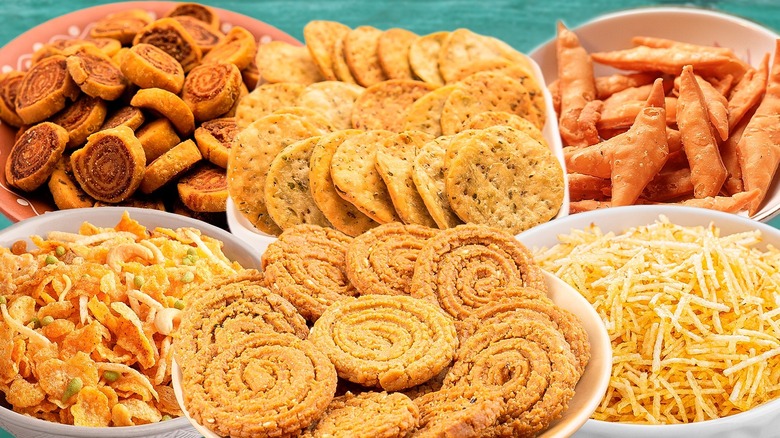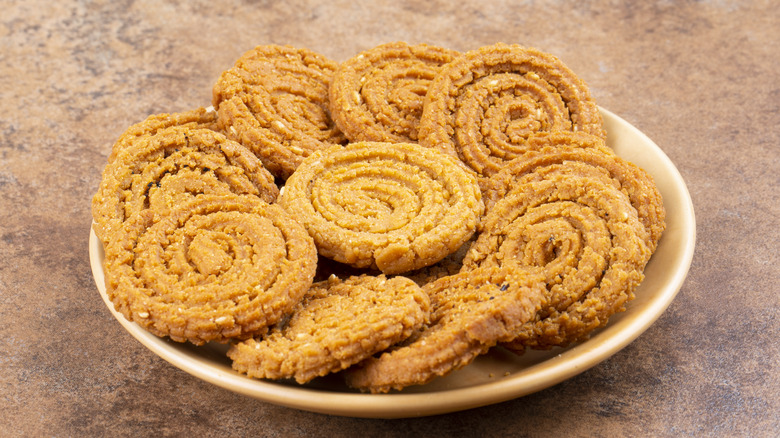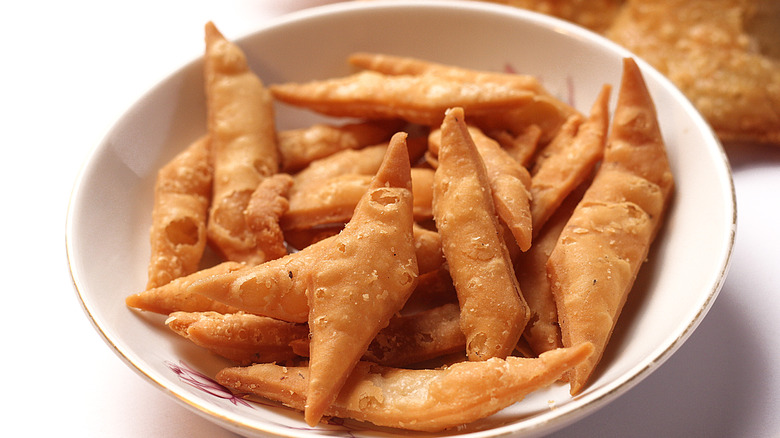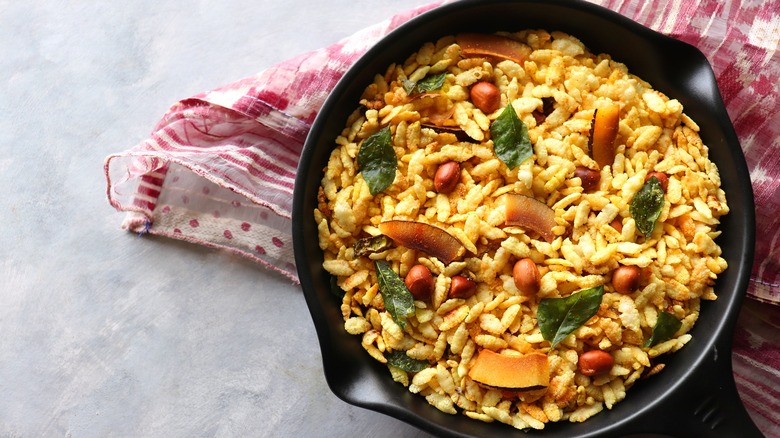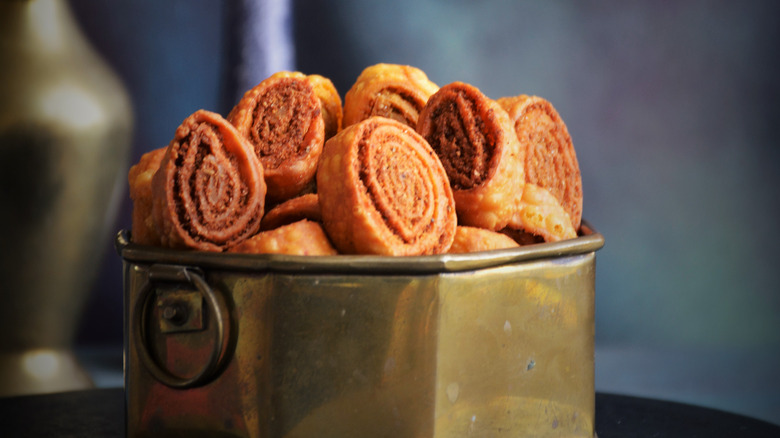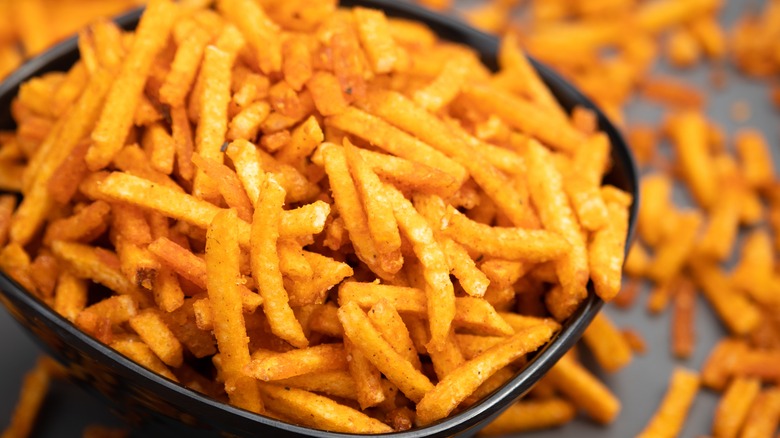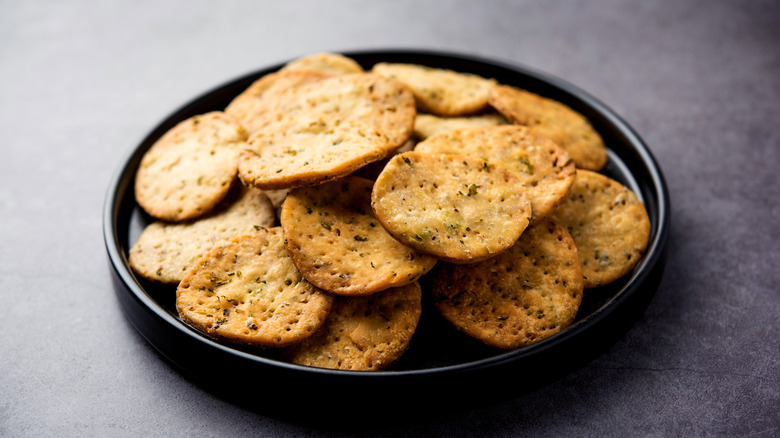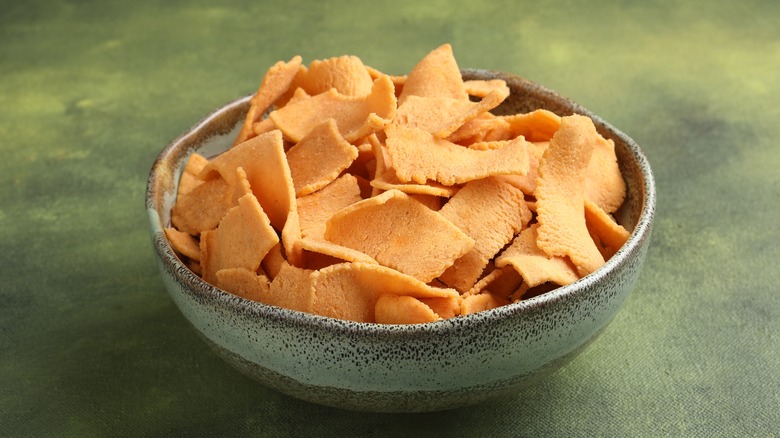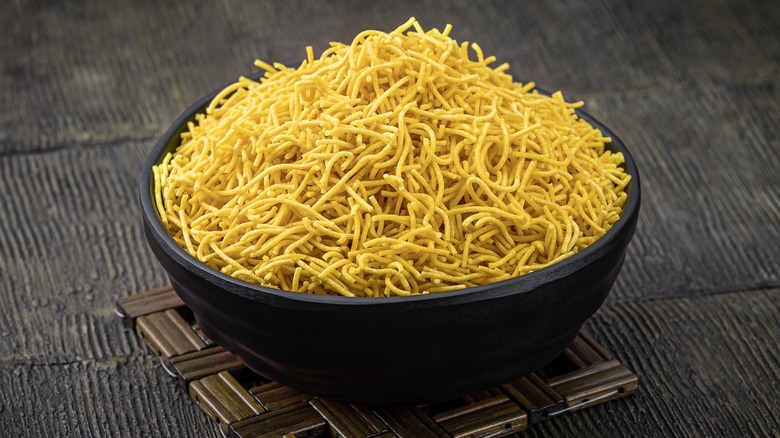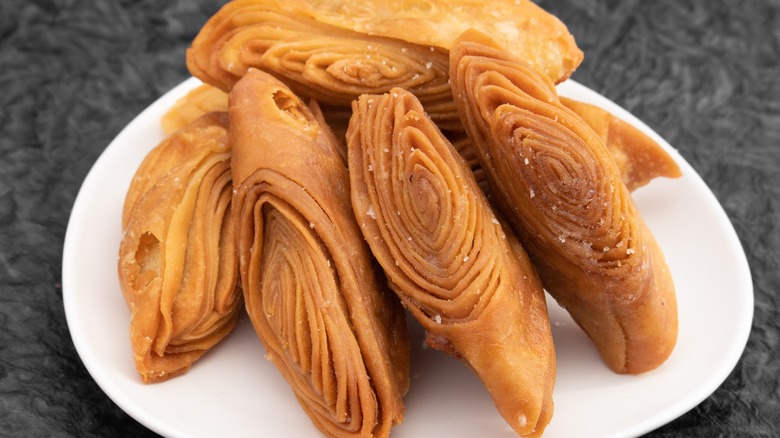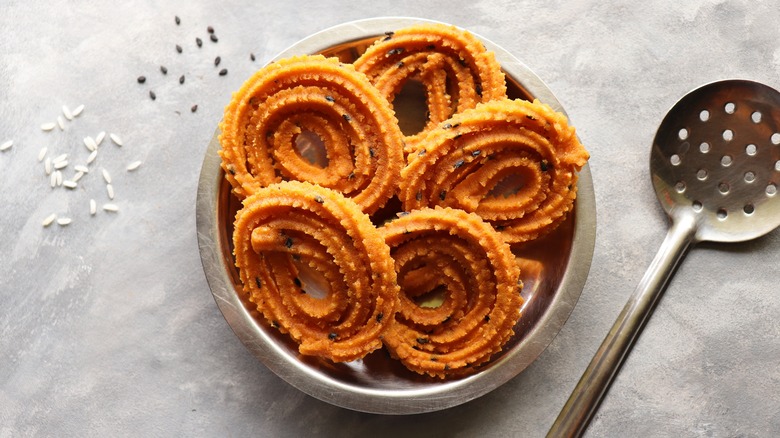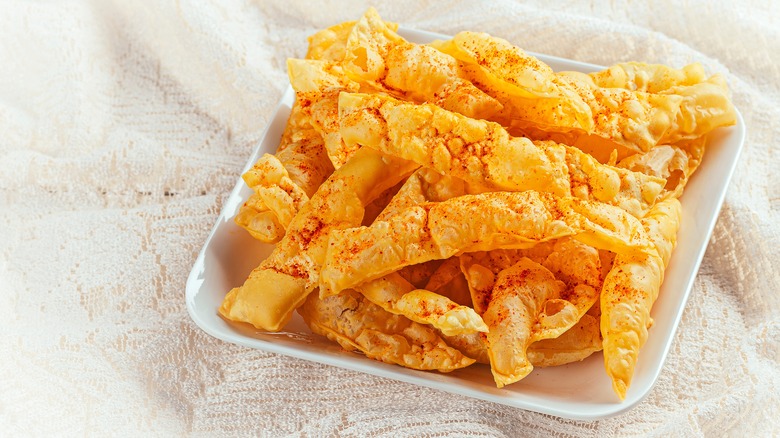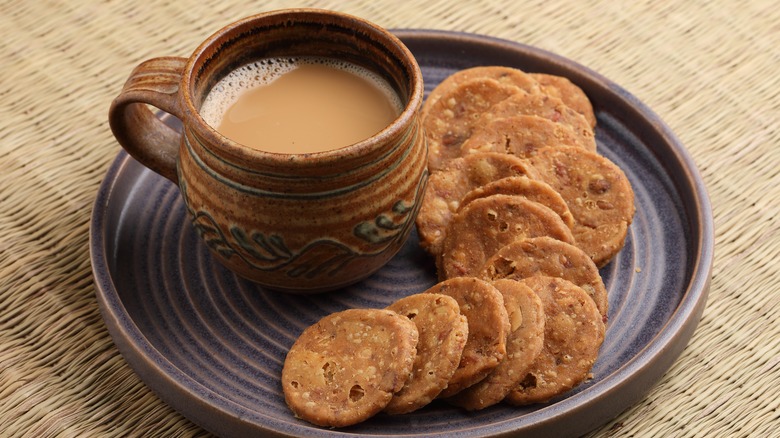12 Traditional Diwali Snacks You Need To Try
As fireworks burst, painting the night sky with dazzling colors, bangle-clad hands meticulously place flickering clay lamps on windowsills. The floors come alive with rangoli, intricate patterns drawn in vibrant chalk colors. Men and women don their most elegant attire, adorned with luxurious silks and glittering gold jewelry. Diwali, the celebrated festival of lights, stands as one of the most momentous occasions in India. Around the globe, millions of people from Dharmic religions come together to celebrate this five-day festival, and such a grand celebration necessitates meticulous preparations — not least of all, food.
Because Indian festivals follow a lunar calendar, the dates change annually. However, preparing for Diwali feasts usually starts a little less than a month before Dhanteras (the first day of the festival), and one of the first tasks to check off the to-do list is making namkeen — savory snacks. Unlike freshly made food like air-fryer samosa or vegan gulab jamun devoured on the day itself, these snacks are shelf-stable, meaning celebrants can store them in an airtight container until the special occasion, cutting down on pre-festival stress.
Whether you're a Diwali celebration veteran searching for new delights or a newcomer eager to discover Indian festive foods, get ready to embark on a culinary journey full of tantalizing regional snacks and beloved classics. Our collection features a variety of crispy, buttery, and fiendishly moreish treats that promise to please every palate, making your Diwali celebration truly special.
1. Chakli
Perhaps more than any other in the world, Indian cuisine is known for delicious, wholesome lentil-based dishes. From soup-like culinary creations such as healthy moong dal to must-try North Indian mithai (sweets), pulses form the backbone of India's gastronomic landscape.
Amazingly, it doesn't stop there; Indian people also make mouthwatering snacks with lentil flour, like this West Indian Diwali specialty, chakli. The treats are brittle, crunchy, and nutty. First, home cooks make a dough from a mixture of flours — which grains are used varies regionally, but typically, it's a combination of rice flour, black lentil flour, and chickpea flour. Once spiced with fiery chili powder, golden turmeric, earthy coriander, sesame seeds, and thyme-scented carom seeds, the nutty flavor of the lentil flours comes to the forefront. Cooks use a unique press to shape the dough into its distinctive spiced spiral shape before frying the chakli until golden brown and crisp.
Ancient Ayurvedic texts mention a savory delicacy named "saskuli," made in much the same manner as modern-day chakli (only with the addition of lotus root to the dough), indicating that the Diwali snack has likely been part of the festival traditions for centuries. The name and recipe for "chakli" were referenced in a text as far back as 1509, claiming the dish was native to Karnataka and later spread to neighboring Maharashtra. Remarkably, chakli's popularity endures in these states even in our modern world, over five centuries since the text was published. We highly recommend trying it this Diwali.
2. Namak para
If you love the crunch of savory crackers, you're guaranteed to love namak para. These diamond-shaped snacks are the spicy sibling of shankarpali, a Diwali staple in homes across India. However, unlike shankarpali, which is sugary-sweet and milky, namak para is flaky, buttery, salty, and gently spiced with freshly ground black pepper, plus carom and cumin seeds.
Unlike Western crackers, people don't eat these bites with cheese, instead choosing to relish them as a tea-time treat. Like most of the Diwali snacks shared here, they're shelf-stable, meaning families usually begin the preparation around Dussehra (a Hindu festival that falls around 20 days before the beginning of Diwali), then store the snacks in a container until the festivities start. I don't know about you, but I don't think I could have the self-control for that — namak para is too moreish.
The preparation is straightforward: all-purpose flour is rubbed together with hot melted ghee (this creates that gorgeous crispy, layered, and buttery effect), seasoned with spices, then kneaded into a soft dough with water. After being cut into the classic diamond shapes, it's deep-fried until puffy and bubbly. In Hindi, the name namak para literally translates to "salt pieces" — namak meaning salt and para meaning pieces — perfectly describing these tempting snacks.
3. Chivda
Say goodbye to trail mix or chip packets — chivda is about to become your new go-to snack. Chivda can be best described as a group of foods rather than one specific recipe and is also sometimes called "farsan," "mixture," or "namkeen," depending on the regional language. The recipe always includes an assortment of crunchy fried items mixed together and tossed in a special spice blend made from fragrant curry leaves, chili powder, salt, and even powdered sugar.
The chivda base almost always includes roasted poha (flattened rice flakes), fried lentils, cornflakes, sev (crispy chickpea flour noodles), puffed rice, makhana (foxnuts), and deep-fried peanuts or cashews. From there, it's easy to adapt the recipe to your own tastes by adding roasted coconut, sugar, or grated jaggery for sweetness, fresh split green chilis for extra fruity spice, garlic for the sweet, pungent aroma, or dried fruits like raisins, which provide soft, chewy, natural sweetness.
Perhaps it's the inherent versatility that has made chivda a Diwali staple, the fact it's naturally plant-based, or maybe that it's so finger-licking good. Either way, if you can get your hands on some of this unique mixture for the Indian festive season, don't pass up the chance. Various varieties of chivda are always available in specialist Indian stores, or you can make it at home by deep-frying or dry-roasting those essential ingredients.
4. Bhakarwadi
While these treats may look similar to miniature cinnamon rolls, once you take a bite, you'll realize bhakarwadi has an entirely different flavor incomparable to anything else. The tiny spiral-shaped nibbles, also known as pinwheels, have a unique blend of seasoning distinctive to the Maharashtra state of India: equal amounts of tongue-tinglingly spicy, sweet, and tangy with undernotes of fruitiness.
The outer dough is comprised of turmeric (for color) and chickpea flour, imparting a nutty and heavier, crisper taste, plus oil and water. However, the filling is where this recipe comes alive — and believe us when we tell you, you'll never have smelt anything this good. Roasted sesame seeds, poppy seeds, finely grated coconut, and fennel seeds combine to make a traditional tempting toasted, sweet, and aniseed-like aroma. When combined with tart dry mango powder, tangy Kashmiri chili powder, pungent garlicky asafoetida, earthy coriander powder, cumin powder, and traditional Marathi spice blend goda masala, the stuffing creates an incredibly complex flavor profile — tropical, fiery, sweet, and nutty all at once.
To create the spiral effect, roll the dough thin, spread it with sharp and fruity tamarind chutney, then sprinkle over the gorgeously aromatic spice mixture. Roll it up and cut it into the spiral rounds before deep-frying or air-frying. These bhakarwadi encompass elements of every flavor profile, allowing you to serve them on a platter alongside desserts, savory pick-and-mix style food, or a teapot of steaming hot masala chai.
5. Aloo bhujia
You may have noticed spicy aloo curry on Indian restaurant menus — even ordered it. If so, you'll know that the Hindi word aloo translates to potato. However, although these morsels may look like French fries, the recipe isn't that simple. It's a festive treat, after all!
The creation of bhujia — or Bikaneri bhujia, as it's often known — is older than you may expect, dating to around 1877. The moniker developed from its birthplace, a colorful, bustling city filled with romantic sandstone forts, dusty alleyways, and a quiet cottage industry of women making and selling the famous bhujia. The vast Thar desert surrounds Bikaner, with dunes stretching for miles and camel herders traversing the land. The arid climate supported the thriving of the crispy snack, bhujia, as it only required moth bean flour, chickpea flour, and a few spices such as cooling mint powder, zingy chaat masala, and peppery ginger.
It was here, in Bikaner, that Ganga Bishan Agarwal founded the legendary Indian snack company, Haldirams. They made their fame and fortune by selling bhujia. It didn't take long for people all over India to make the moreish nibbles a Diwali food tradition. Aloo bhujia, the most prevalent variety of the snack, has one special addition: mashed potato in the dough, making it extra crisp — after all, potato makes anything taste better, doesn't it?
6. Mathri
Much like namak para, mathri is a type of savory biscuit — flaky, irresistible, and intensely flavorful. However, it's essential to note the significant differences between the two. Namak para boasts a thick, buttery texture, while mathri stands out with its unique preparation. Cooks use a fork to pierce mathri before cooking, preventing them from puffing up and resulting in a wafer-thin, crisp texture that sets them apart from other Diwali nibbles.
Some suspect that mathri originated from the desert state of Rajasthan since the harsh conditions make its accessibility to fresh food tough, necessitating shelf-stable foods — like mathri. Over time, however, the food has spread to other corners of India. From Punjab, where it's often eaten for the Karva Chauth festival, to the capital, Delhi, where at every street corner vendor sells it come Diwali, every area has its own unique interpretation of the snack. The most beloved variations have dried fenugreek leaves kneaded into the dough, a mixture of pickle spices integrated into the dough, or a sprinkling of cumin seeds through crackers.
Because mathri has such a long shelf life (more than a month if you store them correctly in an air-tight container), Indian people love to make them ahead of time and pull out the delicious snacks if any unexpected guests come by during the festive period. Although, if you ask us, you don't need any excuse to grab the jar and get nibbling.
7. Ribbon pakoda
Take a virtual journey to the South Indian state of Tamil Nadu this Diwali by indulging in their beloved regional snack, ribbon pakoda. These crispy, spicy, and mouthwatering treats defy the typical expectations of pakodas. Unlike the better-known standard pakora recipe, which usually consists of onions or other vegetables in a fluid chickpea flour-based batter, these Tamil treats have a completely different ingredient list and method. Nonetheless, pakora and padoka (the difference in spelling is due to transliterating regional languages) all signify the same concept — crunchy fritters.
In years gone by, people made ribbon pakora by soaking raw rice, grinding it to a paste, and combining it with other ground grains, like chickpeas and yellow chana lentils. This method is very time-consuming, so most modern cooks use pre-made rice flour instead, along with spices of their choice. The real key to getting the most flavor into your ribbon pakoda? Infusing the water used to mix the dough with crushed green chillis and garlic ... yum.
Like many other Diwali snacks, you need an unusual tool called a sev sancha to make the ribbon pakoda quickly. Since this can be difficult to find in Western countries, many cooks buy the snacks instead — your best chance of nabbing some yourself is by heading to the closest Indian market.
8. Sev
Particular snacks are satisfying on their own, requiring no additional accompaniments, while others harmonize perfectly with meals or other snack options. Sev falls into the second category, as while it's easy enough to reach into a bag and eat handfuls of the irresistibly crunchy chickpea noodles at a time, the snack is also an essential component of many Indian dishes.
Sev, made with chickpea flour and basic seasoning, is gluten-free and packed with plant-based protein. It's not a replacement for regular wheat noodles, as it's always fried. Instead, many Indian recipes call for sprinkling the crisp snack over street food dishes like chaat or misal pav, or incorporating it as a base for snacks like chivda. The smallest noodles, called nylon sev, are primarily used for chaat. Thicker sev noodles, on the other hand, provide a more intense flavor and are occasionally used in festive dishes such as Gujarati sev tameta nu shaak. This dish is a tangy, sweet, mildly spicy, and wholesome curry.
Ultimately, it's no wonder sev is such a beloved Diwali snack since it's so versatile, with neverending possibilities of recipes. It's a storecupboard essential for the festive period.
9. Verki puri
There are three main varieties of puri in Indian cuisine: cooks make tiny, crisp, hollow shells from a semolina-based dough and then fill them with a variety of stuffings to make beloved chaat dishes such as pani puri or dahi puri; large, soft, puffy bread eaten with aromatic chana masala and halwa; and finally verki puri, flaky, layered snacks flavored with black pepper and eaten with masala chai. Households enjoy each variety of puri during India's festive period, but perhaps none more so than verki puri.
Also known as farsi puri, the finger food is Gujarati in origin. While some people may assume that "farsi" refers to the Persian language, farsi means crispy in Gujarati — perfectly describing the tasty morsels, which achieve their characteristic texture by rubbing hot ghee into the dough, then creating a rustic puff pastry by spreading more ghee between layers of dough, before rolling it into the standard spirals.
Farsi puri tastes unbelievable paired with tangy Indian mango pickles. The slightly peppery, rich, and buttery flavor is contrasted with the intensely sour, spicy condiment, making a flavor explosion in the mouth. While this foodie delight used to be exclusive to Indian royalty and the upper class, accessibility to ingredients meant that the average Indian household could indulge in the pleasures of eating verki puri — and so can you.
10. Butter murukku
Meet murukku, the South Indian counterpart to chakli. While chakli and murukku are seasoned with earthy cumin or sweet sesame seeds and look alike, a slight difference in the dough drastically affects the taste. Chakli dough uses a combination of three or more lentil and grain-based flours, while murukku uses two: rice flour and roasted chana flour, resulting in a much crisper and less dense bite.
Similarly, while various regional variations of murukku exist, butter murukku stands out as the most beloved. True to its name, this treat contains an abundance of butter, infusing the savory twists with a deliciously rich flavor and making them the lightest among all its variations. The sign of an exceptionally well-made butter murukku is if it breaks easily. It's for this reason that although murukku means "twist" in Tamil, some shops prefer to sell them in pieces, as the tidbits should be so delicate they snap instantly.
Visit any South Indian home during the month-long run-up to Diwali, and you'll likely find the nutty, buttery scent of murukku wafting through the house as elderly grandmothers fry them in huge kadai full of hot oil or ghee. Although intended to be eaten at room temperature (with a shelf life of up to a month), we sometimes can't resist having one (or two) straight after cooking these flavorful nibbles.
11. Chorafali
One look at these puffy, spice-dusted chorafali, and we start planning when to make them. Many famous Diwali snacks find their roots in the West Indian state of Gujarat, and chorafali is no different. Unlike a similar-looking snack, fafda, chorafali hasn't picked up popularity throughout the rest of India, making them a must-try for all enthusiastic culinarians seeking authentic food experiences.
Not many people have heard of the main ingredient in chorafali — chola dal (hence the name), or in English, cowpeas. The unique starchy lentil is buttery sweet and lends a uniquely distinctive taste to the traditional chorafali. However, since the ingredient is challenging to uncover even in India, many recipes substitute the chola dal flour with a blend of chickpea flour and urad dal flour (split black lentils). Also, because this snack is a regional specialty, chances are that if you'd like to try chorafali this Diwali, you'll have to learn how to make it yourself. The dough, stiffened with minimal water, undergoes thorough pounding to achieve a softer consistency. It is then rolled out thinly, dried, cut into strips, and deep-fried. They puff up gloriously, making a tantalizingly light and crispy texture.
And the finishing touch? A sprinkle of blended tangy spices like pungent black salt, sour dry mango powder, and fruity, fiery red chili powder elevates the chorafali to new heights.
12. Thattai
In the U.S., it's customary to dunk sweet treats into your tea or coffee. Don't get us wrong — Indian people love dipping Parle-G cookies in their chai — but they also have a sweet spot for pairing savory morsels with the malty, sweet, milky drink. Personally, we recommend pairing these thattai crackers with a glass of warming spice-infused masala chai.
Thattai is thin and crispy South Indian rounds made from a nutritiously dense lentil and rice flour dough. Where the recipe really shines, though, is in those added extras: a classic menagerie of South Indian flavors, including fragrant curry flavors, the heat of peppery ginger, garlicky asafoetida, and sweet slivers of coconut. Additionally, as long as the components needed for the dough are proportioned correctly, you can experiment as much as you like by adding finely grated vegetables, aromatics, diverse spice combinations — or even sugar if you have a sweet tooth.
